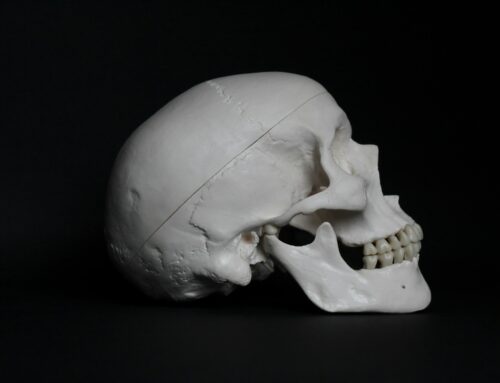Temporomandibular Joint Disorders – known as TMJ disorders – are highly debilitating. This condition involves pain in the joint between the jawbone and the skull. While they are common, there are a lack of treatment options. With the treatments that do exist, outcomes are often poor. So why are TMJ disorders so painful and difficult to treat?

Anyone that has had dental pain will know how debilitating it can be. It can hurt to eat, chew and even speak. However, sometimes this pain can go further – to the extent where it becomes what is called a Temporomandibular Joint Disorder [1].
Temporomandibular joint (TMJ) disorders are known to cause pain and discomfort to those that suffer with them. The internet features many horror stories of patients who have gone to great lengths to contain the pain from these disorders.
But what is it about TMJ disorders that make them so painful? Moreover, how are they caused? Also, why are they so difficult to treat?
What is the Temporomandibular Joint?
A good starting point is to look at the actual joint that this condition relates to. The temporomandibular joint connects the jawbone to the skull.
This joint is heavily used. Whenever we eat, chew, drink or even speak, we are constantly using this joint. Therefore, it is a crucial joint to look after.
What is TMJ Disorder?
With the above in mind, when a problem concerning the joint arises, it can turn into a disorder. Pain and discomfort are common consequences of this.
Symptoms include jaw, ear and temple pain, a headache, difficulty in opening the mouth fully, a feeling of the jaw being “locked”, and popping or clicking noises when the jaw is moved [2]. TMJ disorders cause pain and stiffness in both the jaw and face.
TMJ disorders are very common – with them affecting up to 33 million Americans [1]. They are more common in women.
It isn’t entirely clear what causes TMJ disorders. Teeth grinding, stress, ill-fitting fillings or dentures and poor oral health have all been put forward as potential causes.
It is important to state that many cases of TMJ disorders clear up on their own, without any intervention needed. However, some require medical treatment.
Difficulty in treatment
Despite these disorders causing problems and misery for so many, there are limited methods of treating these disorders.
Currently, mild painkillers are often prescribed. Ice and a diet of soft food are normally suggested. But these are short-term fixes, rather than long-term solutions.
Dentists have sought ways of healing TMJ disorders for almost a century, albeit with little success. The subject area remains under-researched – according to an investigation by KFF News and CBS News [1].
In fact, some research suggests that some treatment for TMJ disorders can do more harm than good. For example, some have found themselves needing numerous surgeries over multiple years, or needing their jaw joints replaced by metal hinges [1].
Splints and orthodontics are normally used by dentists. However, these have limitations. This is summed up by comments made by the director of the National Institute of Dental and Craniofacial Research – Rena D’Souza – who has said there is “not a lot of evidence” behind splints being suitable [1].
Moreover, D’Souza says that the “treatments overall have not been effective” as “we don’t understand the disease” [1]. She acknowledged that TMJ disorders have not been “taken seriously” for many decades [1].
Research has shown that dentists have received “minimal or no training” on TMJ disorders, resulting in patients often being harmed by the lack of proven treatments [1].
Horror stories
As mentioned, there are several horror stories on the internet of people that have struggled with TMJ disorders.
One person, Lisa Schmidt, says that after a diagnosis of TMJ disorder in 2000, she was given a splint to treat it. Within 3 days, Schmidt says she was in “excruciating pain” and could not eat solid food. Therefore, this led to her being stuck on a “surgery carousel” which culminated in her leaving her job. Further treatments led to even more pain for Schmidt [1]. Sadly, this isn’t an isolated case.
Moreover, others who have exhausted all options end up using a treatment that is seen as a last resort – replacing their jaw joint with synthetic implants [1]. However, these devices have caused controversy in the past due to safety concerns.
The future
Efforts are ongoing in terms of trying to improve treatment of the condition. Numerous research studies are underway, each looking into the disorder.
Past research into the topic has been criticized for being inadequate and poorly-designed, according to a 2020 report that called for improved treatment for those with the disorder [3].
The American Dental Association’s President Linda Edgar has said that she sees “great potential” in new research into the condition, with the aim of creating effective treatment options [1].
Terrie Cowley leads the TMJ Association, which is an advocacy organization for those with TMJ disorders [1]. Cowley says that she has spoken to tens of thousands of patients with the disorder. Cowley says that she advises many patients to avoid treatment for TMJ disorder entirely [1].
When we see this attitude from those that suffer from the condition, it is clear that better treatment options are needed. There are definitely flaws which are causing substantial chronic pain for many.
Hopefully there will be improvements in this treatment soon. Whether this is through better education of dental professionals, or improvements in actual treatments – there is plenty of room for improvement. The aim is that this will improve treatment outcomes and the quality of life for patients.
Thinking points…
[1] Having strong oral health is crucial. Avoiding oral problems wherever possible can save us from pain. Therefore, make sure you take good care of your oral health! Moreover, ensure you attend regular dental appointments, so that your dentist can review your mouth and let you know if treatment is needed. We recommend booking an appointment now!
[2] Researchers have suggested that one of the biggest problems with TMJ disorder is the lack of knowledge and awareness of the condition. With this in mind, you could share this article with friends, family or your social network! This can help to raise awareness of its importance. Better yet, if you know someone with TMJ disorder, you could send this article to them! Why not share the article now?
What we offer at Taradale Dental
Taradale Dental is a dental clinic based in Calgary, Alberta, Canada. At our Calgary dental clinic, we provide a range of services for our patients.
We advise our patients to attend our Calgary dental clinic at least twice per year for a regular dental check-up. At these check-ups, we provide a comprehensive review of a patient’s oral health. If any problems are detected, we have many treatments available. For example, these include cavity fillings and root canals. To strengthen your oral health, we recommend brushing your teeth at least twice a day and flossing regularly.
Here at Taradale Dental, we also have some cosmetic treatments available! These include dental implants, teeth whitening and Invisalign[TM]! Our patients find that these treatments have a positive impact on their appearance, confidence and self-esteem.
Moreover, the fees of our treatments at our Calgary dental clinic Taradale Dental are set in line with the Alberta Dental Fee Guide. This ensures transparent and fair pricing, with no hidden costs.
We hope to see you soon at our Taradale Dental clinic in Calgary! You can find out more about us by visiting our website https://taradaledental.ca/!
References
[1] Kelman, B., & Werner, B. (2024). The horrors of temporomandibular joint disorders: Chronic pain, metal jaws and futile treatments. Available: https://medicalxpress.com/news/2024-04-horrors-temporomandibular-joint-disorders-chronic.html. Last accessed: 19th April 2024.
[2] NHS. (2023). Temporomandibular disorder (TMD). Available: https://www.nhs.uk/conditions/temporomandibular-disorder-tmd/. Last accessed: 19th April 2024.
[3] National Institute of Dental and Craniofacial Research. (2020). Temporomandibular Disorders (TMD). Available: https://www.nidcr.nih.gov/sites/default/files/2023-07/fy-2024-significant-items-tmd.pdf. Last accessed: 19th April 2024.


